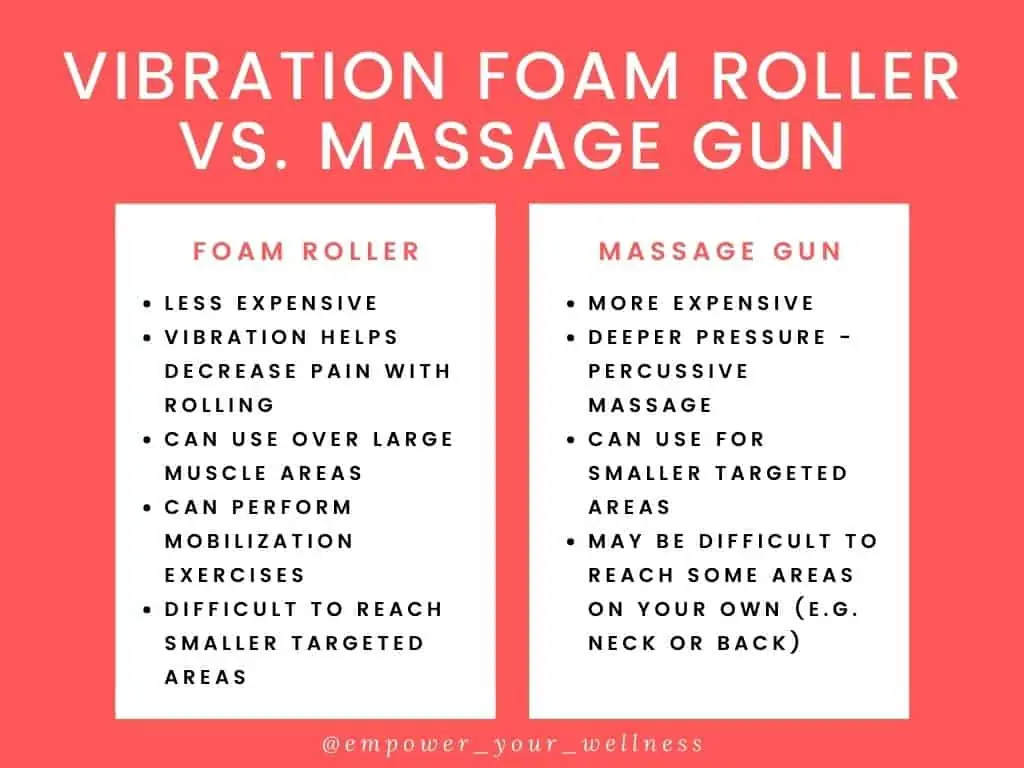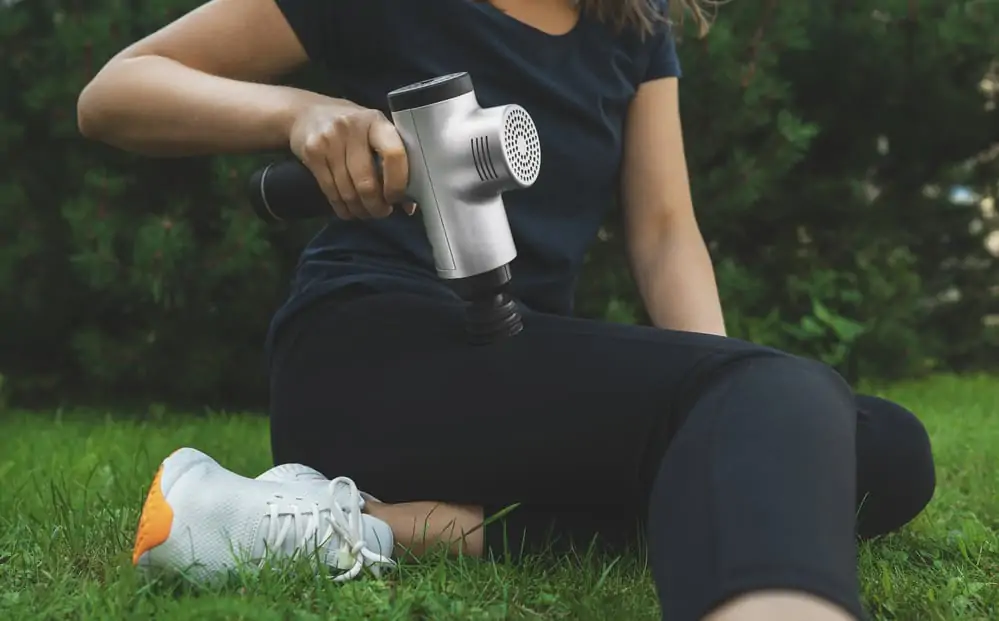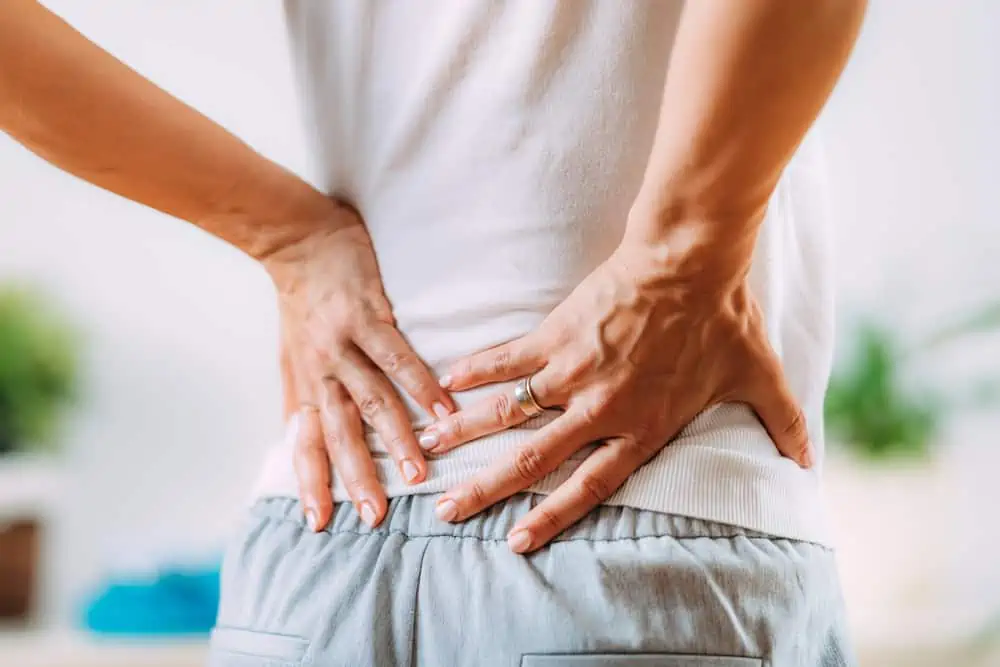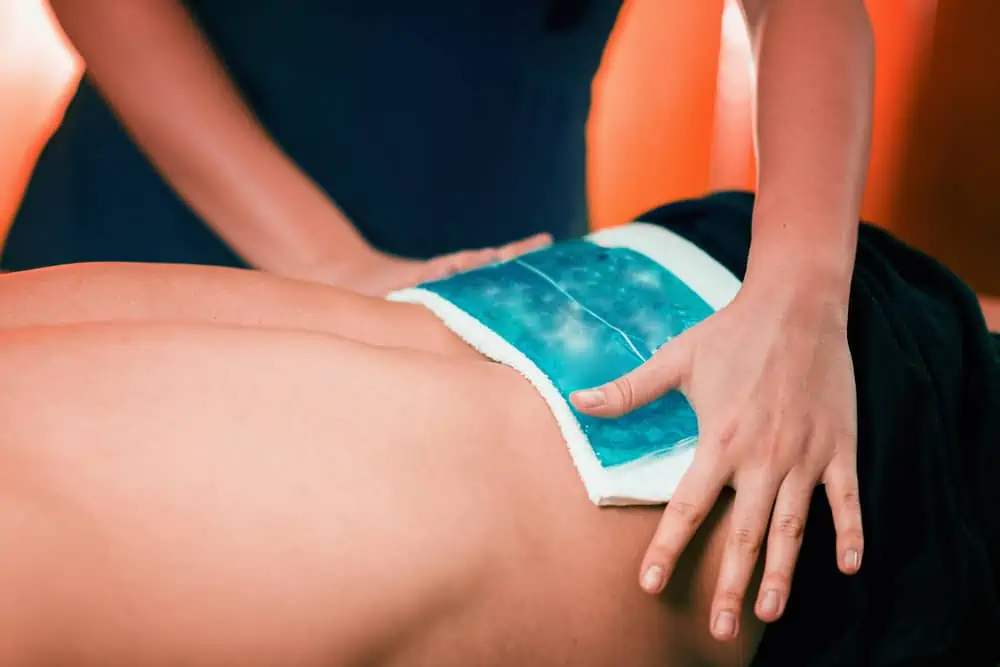This post may contain affiliate links. If you click through a link and make a purchase, I may receive a commission at no additional cost to you. As an Amazon Associate, I earn from qualifying purchases. Read the full disclosure here.
Wouldn’t it be great to get a massage every day and melt away your aches and pains?
Here on planet earth, that isn’t possible for most of us. But there are plenty of fitness gadgets to get some workout recovery and pain relief at home.
Both foam rollers and massage guns aim to improve blood flow and decrease soft tissue restrictions by way of myofascial release – which sounds totally fancy.
But what’s the difference between these devices and which one is best for you? Find out in this detailed comparison.
If you’re in a hurry, my favorite massage gun is Hydragun, and you can check them out here.
Disclaimer: This content is for educational purposes and is not medical advice. Read the full disclaimer.
What is myofascial release?
Myofascial release is a term that people like to throw around because it sounds cool. Let’s back up just a bit to discuss what it is and why you might want to use these devices in the first place.
To answer this question, we have to start with fascia (which is getting plenty of attention these days in the fitness and wellness world).
Let’s get into the science.
Fascia is described as “an uninterrupted viscoelastic connective tissue forming a functional three-dimensional collagen matrix.” (Kumka M and Bonar J, 2019) Fascial tissue is continuous throughout the body and it supports, divides, and connects all structures.
This fascial connection is what helps our movement patterns and keeps our internal organs from shifting all over the place.
Within fascia, there are different types of fascia, leading to inconsistency in describing various tissues, (and why the use of superficial and deep fascia may not be the best descriptors).
Research confirms that fascia is innervated by sensory nerves, allowing it to play a role in proprioception (your ability to determine where you are in space) and pain.
This total body connection can influence the central nervous system (like regulating blood pressure, fight or flight response, etc.) and can also be tied to emotion and mental health.
Bordoni and Simonelli proposed that fascia promotes synergy among different tissues and that the continuous nature constantly transmits and receives information that can influence the shape and function of the entire body.
When tissue becomes restricted or injured, myofascial adhesions can change the way we move. Fascial restrictions and scar tissue can even cause discomfort, muscle tension, pulling, and pain in other areas of the body that seem unrelated.
Many factors influence the health and mobility of fascia, including various health/mental health conditions, hydration, movement, and activity levels.
Like most systems of the body, not moving creates problems. Although not moving may decrease pain at that moment, moving well is one of the most important things you can do to help myofascial pain.
Some of the ways you can improve the health and mobility of fascia are by:
- Moving well and moving often
- Being aware of your posture and how you hold yourself during activities
- Maintain a well-rounded fitness routine with elements of cardio, strength, flexibility, and mobility
- Use a foam roller, massage gun, massage stick, or other tools to mobilize tissue
- Do yoga
- Get a massage
- Try acupuncture
- Have a professional biomechanical evaluation to assess your movement and provide specific exercises.
So now that we have a handle of fascia, let’s answer the question.
Myofascial release is a hands-on technique used by physical therapists and massage therapists to apply gentle pressure to myofascial tissue to restore function and decrease pain.
Self-myofascial release is attempting to accomplish the same goal using tools like a foam roller, massage balls, or massage sticks.
Myofascial release utilizes the approach of prolonged gentle pressure to decrease tissue viscosity and allow the tissue to elongate.
This is different than deep tissue massage – and contrary to popular belief, more pressure doesn’t equal better.
Now, let’s get to vibration foam rollers vs. massage guns.
Benefits of vibration foam rollers
A vibrating roller comes with all the benefits of a regular foam roller, plus the ability to emit pulsed vibrations.
Foam rollers are often used as part of a warm-up and in workout recovery. Cheatham et al. concluded that foam rolling may be useful for enhancing joint range of motion both pre and post-exercise.
Foam rollers may produce physiological changes, including increased blood flow, circulation, and the release of inflammatory chemical mediators during the breakdown of trigger points and spasms to promote muscle relaxation.
There’s mixed evidence to suggest that foam rolling after high-intensity exercise might help decrease perceived next-day soreness (DOMS).
The benefits of foam rolling may be more significant when combined with a consistent static stretching program post-activity.
So what’s the big deal with vibration?
There is some evidence that vibration can decrease pain (via the gate control theory), modulating pain sensations sent back down from the central nervous system based on sensations put in.
This is why we feel the need to rub an area after an injury. We’re putting nonpainful stimuli in to help stop painful sensations from coming to the area.
Romero-Moraleda et al. looked at the short-term effects of pain perception and passive hip range of motion (ROM) after using vibration foam rolling to the quads. The study found a significant improvement in pain perception and passive range of motion in hip extension following vibration to the quads.
Imityaz S et al. compared vibration therapy with massage for the management of delayed onset muscle soreness (DOMS). This study concluded that vibration therapy was equally effective in the prevention of DOMS and muscle recovery.
The moral of the story – if you find foam rolling an uncomfortable experience, or are looking for an easy way to reduce post-workout soreness, a vibrating foam roller might be for you.
Best vibration foam rollers
Don’t forget to check out which retailers are offering cash back through Rakuten. Use my referral code to earn up to a $30 bonus on your first qualifying purchase just for signing up.
The Trigger Point Grid Vibe Plus is a great compact vibration foam roller. This roller has 4 different vibration frequencies and a soft foam covering the core of the roller.

The Trigger Point Grid Vibe plus is available on Amazon and Walmart.
If you’re looking for a textured foam roller to work deeper into tight muscles, check out the Phenom Vibrating Fitness Roller.
The FitIndex Electric foam roller is a highly-rated budget option.
This last option is not a foam roller, but a peanut-shaped vibration therapy device – check out the Sidekick Fuse.
A vibrating massage ball can also get into areas that a foam roller can’t.

Benefits of massage guns
Massage guns have similar physiological benefits as foam rollers, but with a slightly different delivery. (My favorite is Hydragun.)
Massage guns are also known as percussive therapy (which often goes hand in hand with vibration therapy), delivering quick bursts of pressure to an area to relieve trigger points and muscle soreness.
Konrad A et al. looked at the acute effects of percussion therapy on calf muscle range of motion and strength.
After five minutes of targeted percussive massage, they noted an improved range of motion and no effect on strength. Therefore, they concluded that using a massage gun before training should not have any effects on performance.
The main advantage over a foam roller is the ability to target specific areas.
There’s also less “work” involved since you can just hold a percussion massager and with a foam roller you need to get on the floor and contort yourself into various positions.
For those looking for deeper, targeted pressure, a percussion massage gun might fit the bill.
Best massage guns
Massage guns run the gamut in terms of price, bells and whistles, and how “cool” they look, but there’s something for everyone.
Theragun and HyperVolt are well-known brands for quality percussion massagers and have a variety of models to choose from to fit your needs.
After much searching, I decided to go with Hydragun and I’ve been very happy. Hydragun brings high-end bells and whistles at an affordable price.
Amazon has several budget option massage guns under $100 to get a sense if this is something that will work for you.
Vibration foam roller vs. massage gun – which is better?
The classic answer – it depends – mostly on your budget and what kind of feeling you’re looking for.
Both can help ease aches and pains from everyday life and workouts and help keep soft tissues moving as part of an overall healthy fitness plan.

Compared to a massage gun, vibration foam rollers are less expensive.
With a foam roller, you can target larger muscle areas and perform mobilization exercises. The added vibration can help ease the discomfort that comes along with foam rolling.
However, with a foam roller, it’s difficult to target smaller areas of the body. The vibration also will not mimic a deep tissue massage in the same way that a massage gun will. You can also try a vibrating massage ball to target smaller areas.
Massage guns can be pricey. There are some budget options on the market, but many of the well-known brands are more expensive.
It’s also difficult to use a massage gun on yourself for hard-to-reach areas like the neck and back.
The pressure of a massage gun may be too much for some people. To alleviate this, you can place a folded towel over the area to absorb some of the force and make massage guns more tolerable.
Wrapping up
Moving well and moving often is the number one way to decrease myofascial pain. Myofascial release tools can be a welcome addition to your fitness program.
Foam rollers and massage guns make it easy to get some pain relief at home to tackle tight muscles from workouts and everyday life.
Leave a comment and let me know which one is your favorite!
You might also like:
- How To Choose A Foam Roller
- The 7 Best Foam Roller Exercises To Combat Poor Desk Posture
- Foam Roller Exercise Library
REFERENCES
Bordoni B, Simonelli M. The Awareness of the Fascial System. Cureus. 2018;10(10):e3397. Published 2018 Oct 1. doi:10.7759/cureus.3397
Imtiyaz S, Veqar Z, Shareef MY. To Compare the Effect of Vibration Therapy and Massage in Prevention of Delayed Onset Muscle Soreness (DOMS). J Clin Diagn Res. 2014;8(1):133-136. doi:10.7860/JCDR/2014/7294.3971
Konrad A, Glashüttner C, Reiner MM, Bernsteiner D, Tilp M. The Acute Effects of a Percussive Massage Treatment with a Hypervolt Device on Plantar Flexor Muscles’ Range of Motion and Performance. J Sports Sci Med. 2020;19(4):690-694. Published 2020 Nov 19.
Kumka M, Bonar J. Fascia: a morphological description and classification system based on a literature review. J Can Chiropr Assoc. 2012;56(3):179-191.
Schleip R, Hedley G, Yucesoy CA. Fascial nomenclature: Update on related consensus process. Clin Anat. 2019;32(7):929-933. doi:10.1002/ca.23423








What a great informative post! I’ve used foam rollers before, but never vibration foam rollers or massage guns. Thanks for going into so much detail about these options and comparing when you might choose one vs the other. Very helpful!
Yes, there are so many fitness gadgets and it’s important to know what they do. Thanks for reading.
Very interesting! I had no idea they even made foam rollers that vibrate. That sounds really soothing
Fitness tech is really getting fancy!
I know massage can be expensive and I never hear of a vibration foam roller I only have the regular one, thanks for this informative article.
Yes, it can definitely be something easy and affordable to use at home in between the treat of getting a massage.